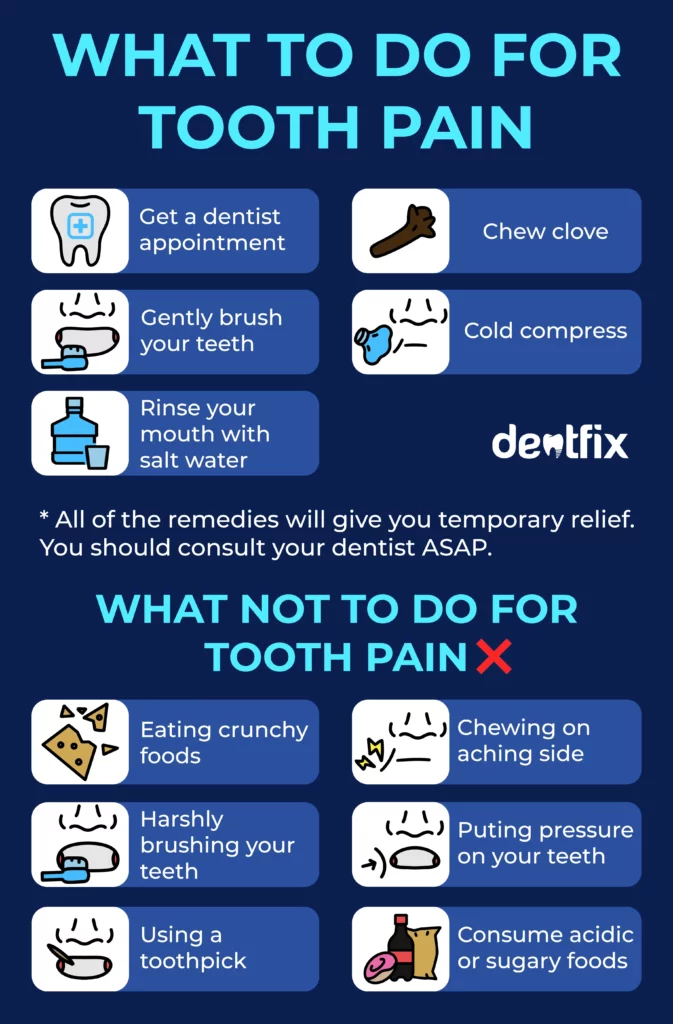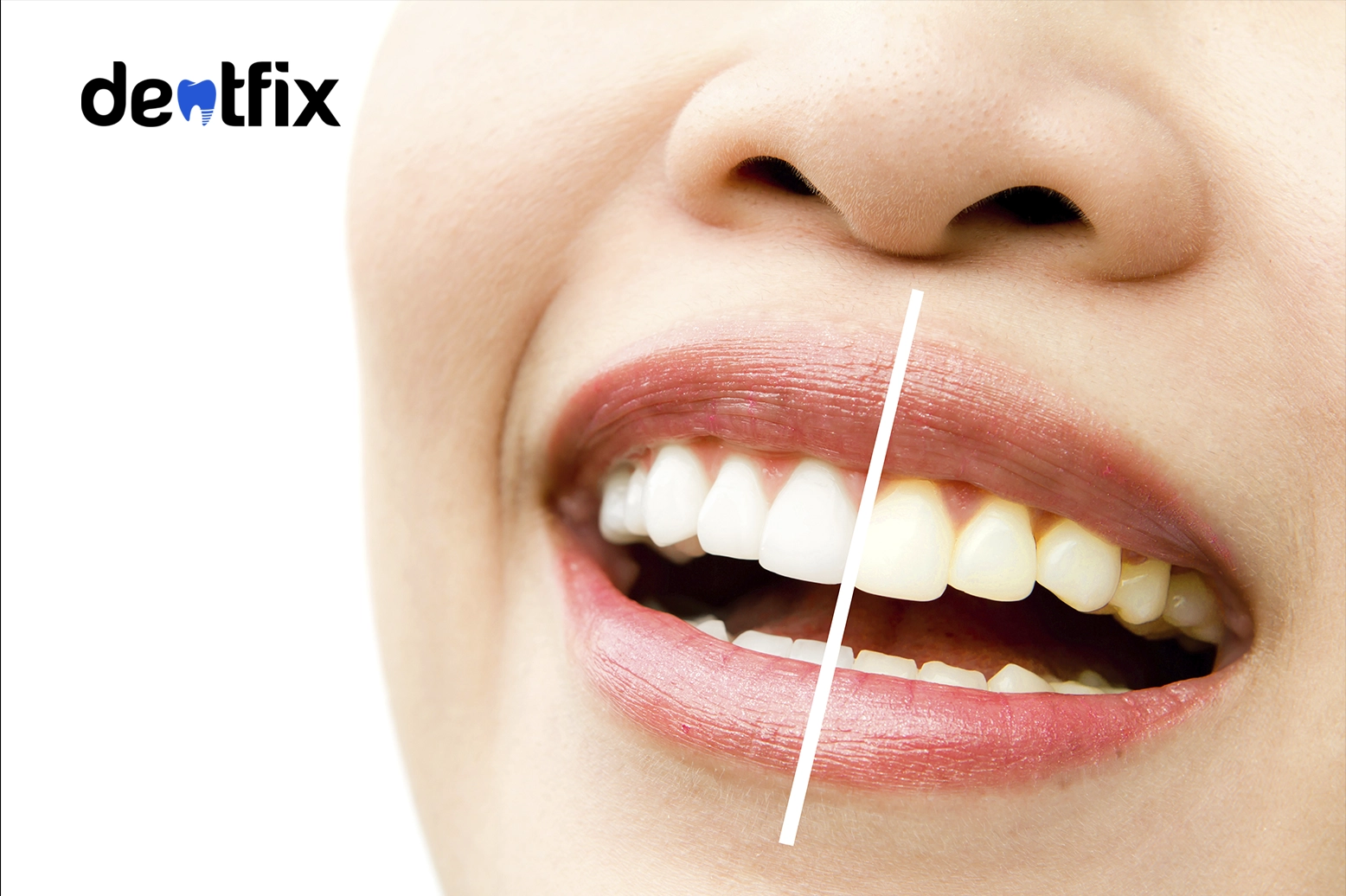
There are many types of tooth pain, and it can be really difficult to go through them.
The remedies can change from cloves to running to the ER depending on the severity of tooth pain. It can come as a minor pain or unbearable tooth pain. Whatever type it is, all tooth pain comes with a reason.
The first action to be taken is to find the cause of the pain. Then, what to do for tooth pain professionally will be known.
Here’s the recap of the article:
- REMEDIES CHANGE REGARDING THE TYPE OF YOUR TOOTH PAIN
- THERE ARE NATURAL HOME REMEDIES
- HOME REMEDIES RELIEVE PAIN BUT NOT COMPLETELY
- BRUSHING TEETH HAS RELIEVING EFFECT ON PAIN
- JAW AND EAR PAIN ARE RELATED TO TEETH
- YOU CAN USE ANTI-INFLAMMATORY DRUGS ONLY IF PRESCRIBED BY DOCTOR
- THERE ARE SAFE REMEDY OPTIONS FOR PREGNANT WOMEN
At-Home Remedies For Tooth Pain
The fastest way to stop a toothache at home has three steps:
- You should use salt water rinse, hydrogen peroxide rinse, or warm water rinse.
- Then, you should chew a clove or apply clove oil to your gums.
- The last step is cold compressing. You can apply ice pack compressing to your cheek.
The rinsing step is effective because they all have antiseptic features and act as a pain reliever. But you cannot use a hydrogen peroxide rinse for every type of toothache pain. It is too acidic. You shouldn’t use it when there is an open wound, exposed tooth nerves, or a crown has fallen off.
Saltwater rinse is safe for every type of tooth pain.
Cloves also have anti-inflammatory features but a natural remedy version. Applying ice back reduces the swelling.
| 💡Remember that these will provide temporary relief. You should consult a specialist for your tooth pain. |
⚠️Tooth Pain During Pregnancy If you are pregnant, you can use home remedies and after that visit your dentist. They will decide the best treatment plan for you and your baby’s safety. |
Does Brushing Teeth Help Tooth Pain?
Yes, brushing teeth with gentle movements helps relieve the dental pain, but the pain does not go completely.
If there is cracked tooth pain, removing food particles will help reduce the pain. Other types of tooth pain will not be affected positively by brushing at that time. You may feel relief, however, it won’t fo away permanently.
Also, when patients have cavities, they may tend to brush that area more vigorously and hard. This is an action that hurts the tooth more rather than relieving it.
Brushing teeth regularly is good for possible toothaches as dental care. However, brushing during pain does not have much effect.
What Is the Best Medicine for Tooth Pain?
The best medicine for tooth pain is in the anti-inflammatory drugs group. It is not a permanent cure for the problem behind the tooth pain. Yet, it is still an effective way to reduce toothache.
These drugs should be prescribed by the doctor. You should use them the way they are prescribed.
What Not to Do When You Have a Toothache
There are some don’ts when it comes to struggling with toothaches. It needs to be paid attention to and act properly while surviving pain. Let’s see what a person with an ache should not do to have gum and tooth pain relief:
- Avoid chewing on the aching side
- Do not apply aspirin directly to the tooth or gum
- Do not drink extremely cold or hot drinks
- Avoid eating crunchy foods
- Do not consume sugar or acidic foods
- Avoid using hydrogen peroxide rinse for every type of tooth pain
- Avoid using too hot or too cold as a compressing
- Do not violently use a toothpick, instead, floss can be used
- Do not apply pressure from outside by hand or inside by tongue
Why Does Tooth Pain Come and Go
If you have tooth pain that comes and goes, you may have cavities, tooth decay, tooth abscess, or your wisdom teeth are coming up. While experiencing these, a pain occurs, continues, and goes. Then it comes back. It is like a loop.
Let’s see how the problems affect you:
Cavity: If there is a cavity in the tooth, the tooth will ache as a result of the food residue that gets filled there and it will go away.
Tooth Decay: If you have tooth decay, it causes throbbing pain that comes and goes due to the acids that are consumed.
Tooth Abscess: At the beginning of the abscess, you will experience instantaneous and coming and going pain.
Wisdom Teeth: Your wisdom tooth, which is trying to come out, may become sore for a certain period and may return.
How Is Ear and Tooth Pain Related?
The ear and tooth have connected nerves. That’s why both infections result in an ache in the ear or tooth. If you have an ear infection, you will also have toothache. If you have a tooth infection, you will also have an earache. Connected nerves result in related ear and tooth pain.
There is a disorder that causes ear and tooth pain at the same time. There is a joint that connects the jaw to the bones on the side of the skull. A dysfunction in this joint causes TMJ (Temporomandibular Joint Disorder). So, if you have TMJ disease, it is possible to experience jaw pain and ear pain at the same time.
Does Sinus Infection Cause Tooth Pain?
Yes. Sinus infection, which is Trigeminal Neuralgia, causes tooth pain. Especially teeth on the upper jaw gets affected by sinus infection more as they are closer to the maxillary sinuses. These sinuses can cause tooth pain when they put pressure on the teeth close to them.
In addition, the rate of sinusitis infection in the maxillary sinuses caused by dental infection is more than 40%.
The sinuses, gums, and teeth have the same nerves, which can explain the link between them.
Why Do Your Teeth Hurt Especially At Night?
There are two common reasons for it and the key reason why it gets worse and worse is the blood flow. Blood flow will be in your head as you lie down. This will be pressure to the teeth and teeth will be more sensitive.
Another reason is that you can focus on other things during the day. Pain increases at night when there is nothing to focus on.
Let’s see the dental problems that can be felt the most at night.
- Sinus infection: The sinus infection puts pressure on the nearby tooth, causing pain at night.
- Teeth Grinding: This means you have bruxism. You grind your teeth in your sleep at night due to stress, and this causes nighttime dental pain.
- Gum recession: It is a type of gum disease. The gum recedes, exposing the tooth roots which are more sensitive than the crown tooth pain, and causing pain.
- TMJ disorders: TMJ, which is related to the jaw joint, becomes worse with jaw clenching and teeth grinding.
- Nerve/Exposed Nerve as Pulpitis: It is an inflammation of the tooth root. It occurs when the broken enamel is close to the pulpal.
- Trauma: Cracked tooth caused by trauma can cause severe pain at night.
- Wisdom Teeth: Intravascular pressure in the teeth increases at night, causing you to feel more severe pain. It causes severe wisdom tooth pain at night.
Why Do Teeth Hurt When You Eat Something Sweet?
When we consume sweet foods, we feel extra pain in the teeth. This is also due to various reasons. Let’s see what you may have to feel tooth pain during eating sweets.
- You May Have Cavities: The acids from the sugar hurt the cavity because there is no protective barrier there due to the cavity.
- You May Have Tooth Damage: Tooth damage will also cause you to be more affected by the acids in sugar.
- You May Have Enamel Loss: Due to damage to the enamel, nerve roots, and pulpal are exposed, and this causes dentin hypersensitivity.
- You May Have Gum disease: Gum disease occurs because of plaque formation and this results in extra sensitivity of teeth.
- You May Have Gum Recession: Teeth become sensitive to the acids in sugar, which can cause severe loose tooth pain after receding gums.
- If You Had Gone Through Teeth Whitening Treatments: After the teeth-whitening treatment, the tooth becomes extra sensitive.
References:
1) Cohen LA, Bonito AJ, Akin DR, Manski RJ, Macek MD, Edwards RR, Cornelius LJ. Toothache pain: a comparison of visits to physicians, emergency departments and dentists. J Am Dent Assoc. 2008 Sep;139(9):1205-16. doi: 10.14219/jada.archive.2008.0336. PMID: 18762631.
2) Pergolizzi JV, Magnusson P, LeQuang JA, Gharibo C, Varrassi G. The pharmacological management of dental pain. Expert Opin Pharmacother. 2020 Apr;21(5):591-601. doi: 10.1080/14656566.2020.1718651. Epub 2020 Feb 6. PMID: 32027199.
3) Kumarswamy A. Multimodal management of dental pain with focus on alternative medicine: A novel herbal dental gel. Contemp Clin Dent. 2016 Apr-Jun;7(2):131-9. doi: 10.4103/0976-237X.183066. PMID: 27307656; PMCID: PMC4906852.
4) Renton T. Dental (Odontogenic) Pain. Rev Pain. 2011 Mar;5(1):2-7. doi: 10.1177/204946371100500102. PMID: 26527224; PMCID: PMC4590084.
5) Fukuda KI. Diagnosis and treatment of abnormal dental pain. J Dent Anesth Pain Med. 2016 Mar;16(1):1-8. doi: 10.17245/jdapm.2016.16.1.1. Epub 2016 Mar 31. PMID: 28879289; PMCID: PMC5564113.
6) Timmerman A, Parashos P. Management of dental pain in primary care. Aust Prescr. 2020 Apr;43(2):39-44. doi: 10.18773/austprescr.2020.010. Epub 2020 Apr 1. PMID: 32346209; PMCID: PMC7186276.
7) Hilton TJ, Funkhouser E, Ferracane JL, Gordan VV, Huff KD, Barna J, Mungia R, Marker T, Gilbert GH; National Dental PBRN Collaborative Group. Associations of types of pain with crack-level, tooth-level and patient-level characteristics in posterior teeth with visible cracks: Findings from the National Dental Practice-Based Research Network. J Dent. 2018 Mar;70:67-73. doi: 10.1016/j.jdent.2017.12.014. Epub 2017 Dec 28. PMID: 29289728; PMCID: PMC5939962.
8) Jacobsen PL, Casagrande AM. Sinusitis as a source of dental pain. Dent Today. 2003 Sep;22(9):110-3. PMID: 14552231.
9) Castrillon EE, Exposto FG. Sleep Bruxism and Pain. Dent Clin North Am. 2018 Oct;62(4):657-663. doi: 10.1016/j.cden.2018.06.003. Epub 2018 Aug 14. PMID: 30189988.
10) Pihlstrom BL, Michalowicz BS, Johnson NW. Periodontal diseases. Lancet. 2005 Nov 19;366(9499):1809-20.
11) Highfield J. Diagnosis and classification of periodontal disease. Aust Dent J. 2009 Sep;54 Suppl 1:S11-26.






